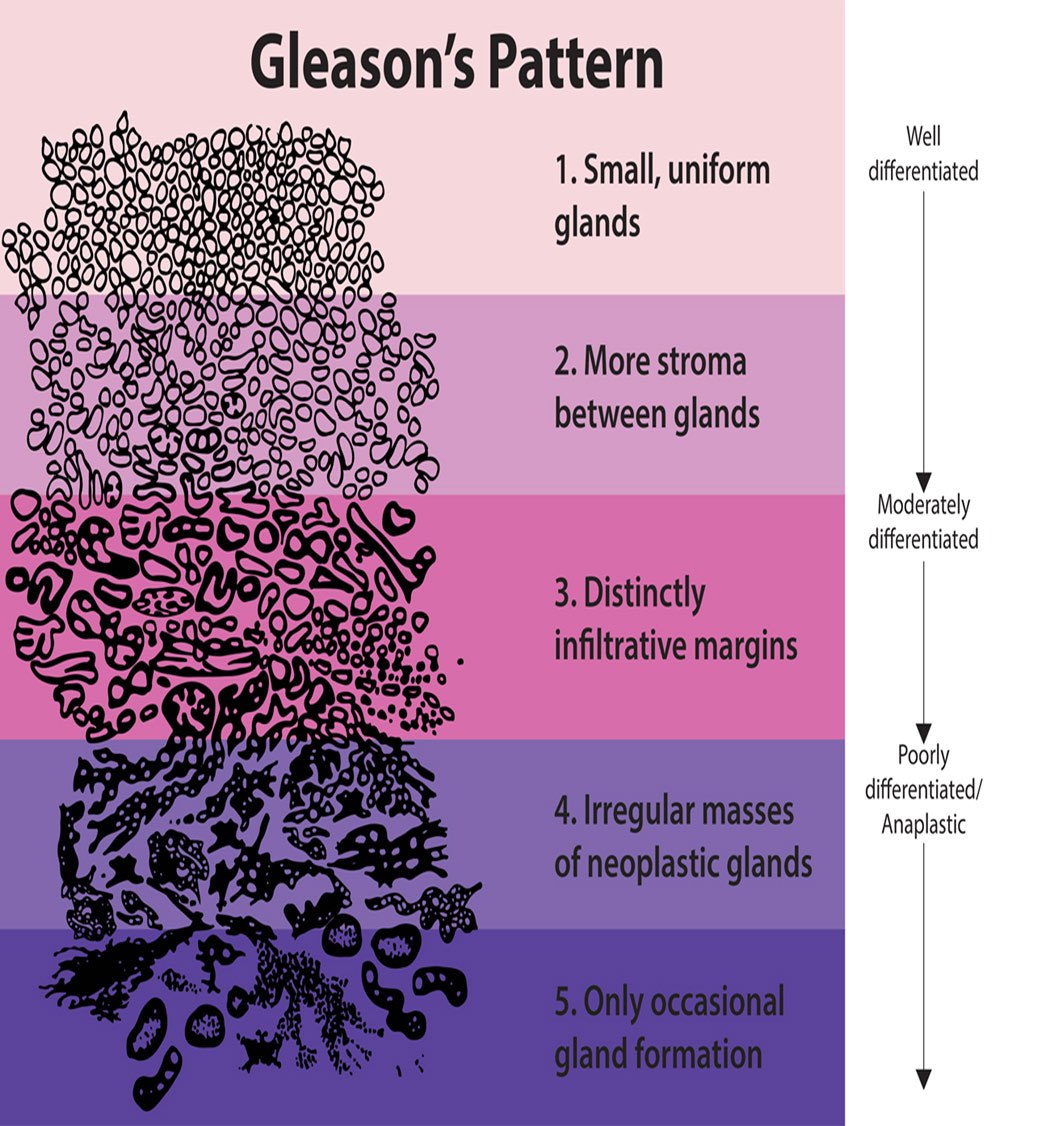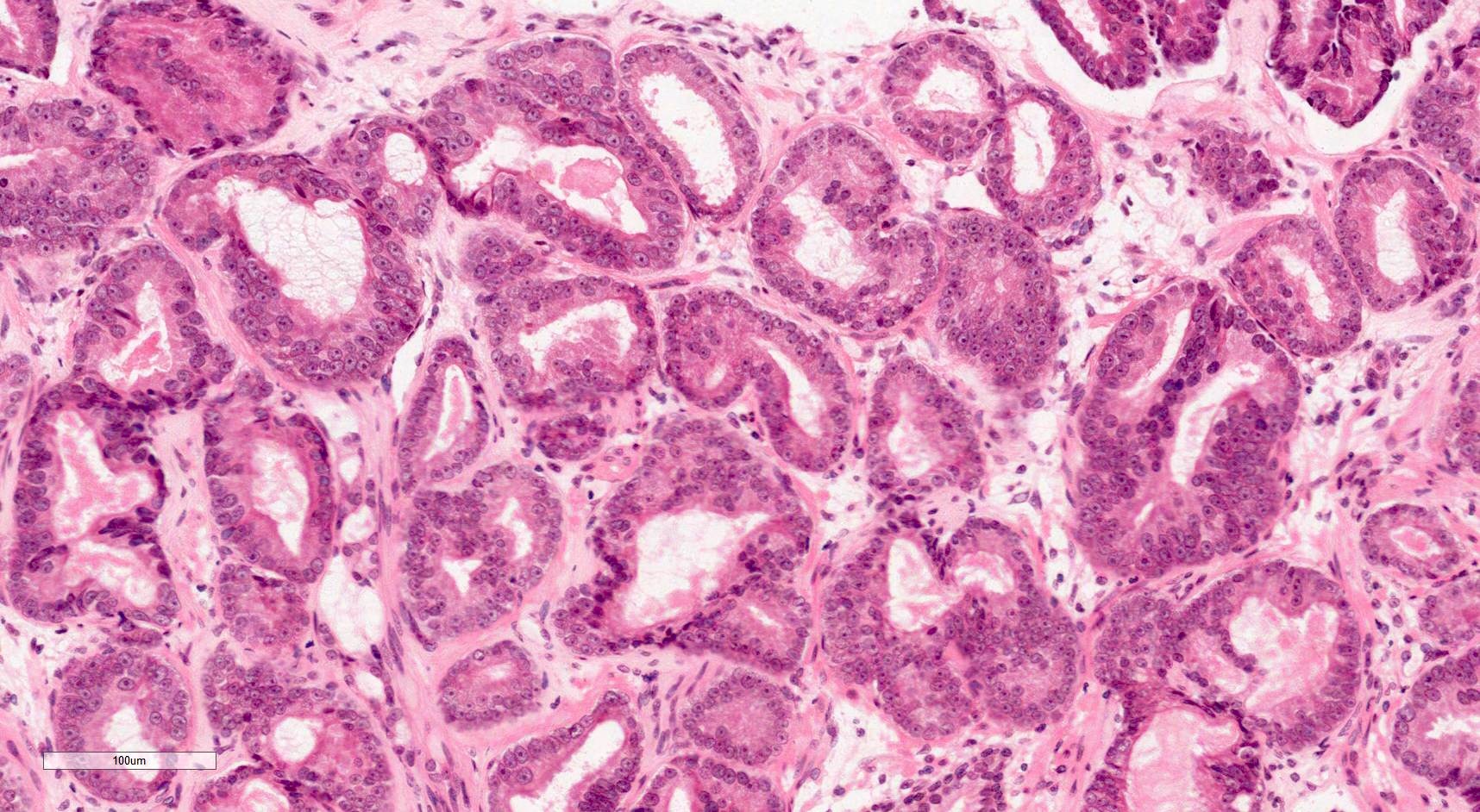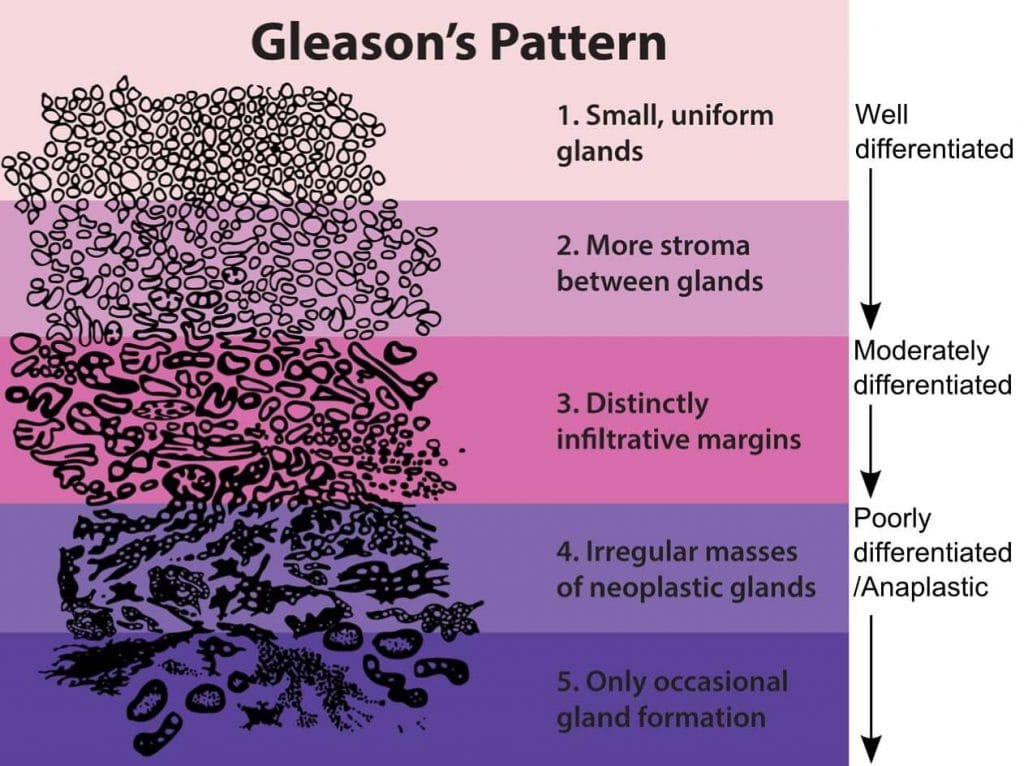
Prostate Cancer What You Need to Know About The Gleason Score CancerConnect
For those laboratories that employ partial samplings as the adopted method for processing radical prostatectomy specimens, inclusion of the entire prostatic periphery and extraprostatic tissue is advised to avoid understaging caused by missingextraprostatic extension. Objective: To evaluate Gleason 7 tumors from radical prostatectomy specimens that were stratified by 3+4 and 4+3 status.

Prostatic Adenocarcinoma Histopathology YouTube
The nodule, 1.3 cm in greatest diameter (volume 0.7 cc), showed the following features: acinar adenocarcinoma (Figure 1A), Gleason score 3 + 3 = 6, WHO nuclear grade 3, negative surgical margin, no extraprostatic extension, even though the tumor reached the so-called prostate capsule, and lymphovascular invasion in the parenchyma adjacent to.

(a) Prostatic adenocarcinoma Gleason pattern 4 + 3; score 7 (H and E,... Download Scientific
Background: There is a worldwide debate involving clinicians, uropathologists as well as patients and their families on whether Gleason score 6 adenocarcinoma should be labelled as cancer. Case description: We report a case of man diagnosed with biopsy Gleason score 6 acinar adenocarcinoma and classified as low risk (based on a PSA of 5 ng/mL and stage cT2a) whose radical prostatectomy.

The Gleason Score Prostate Matters
Adenocarcinoma (prostatic adenocarcinoma) is the most common type of prostate cancer. This type of cancer may also be described as acinar adenocarcinoma because it is made up of groups of tumour cells forming small glands called acini. It develops from epithelial cells normally found in the prostate gland. Adenocarcinoma of the prostate is a relatively common cancer among older men and the.

Tumore alla prostata, arriva il farmaco bomba in grado di curarlo da ora Centro Meteo Italiano
Prostate adenocarcinoma is a common malignancy associated with a significant morbidity and mortality. In both prostate biopsies and radical prostatectomy specimens Gleason scoring informs both treatment and outcome prediction. The current convention is that in needle biopsies, Gleason patterns 3, 4 and 5 are considered to be malignant. Despite this there is debate as to whether or not Gleason.

Gleason 3 4 prostate cancer doctorvisit
The new grading system initially described in 2013 in a study from Johns Hopkins Hospital and then validated in a multi-institutional study, includes five distinct Grade Groups based on the modified Gleason score groups. Grade Group 1 = Gleason score ≤6, Grade Group 2 = Gleason score 3 + 4 = 7, Grade Group 3 = Gleason score 4 + 3 = 7, Grade.

(PDF) Gleason 3 + 3 Ca de próstata en la vigilancia activa con el aumento de PSA no se
118 significant: Gleason score 3 + 3 = 6 acinar adenocarcinoma, 119 3 mm in diameter (volume 0.1 cc), with negative surgical 120 margin and no ex traprostatic ex tensio n (Stage pT2c ) (See

Pathology Outlines Adenocarcinoma
Adenocarcinoma is a type of cancer that develops in gland cells, such as the cells that make up most of the prostate. Adenocarcinoma is by far the most common type of cancer found in the prostate gland.. For example, men with a Gleason score 3+4=7 cancer tend to do better than those with a 4+3=7 cancer (even though they're both.

Escala de Gleason Seu significado no câncer de próstata
Nella pratica clinica i valori dello score di Gleason che si leggono solitamente nei referti istologici sono i seguenti (in ordine crescente di malignità): score 6: 3+3. score 7: 3+4. score 7: 4+3. score 8: 4+4. score 9: 4+5 e 5+4. score 10: 5+5. In generale un tumore con un Gleason score fino a 6 è considerato a " basso rischio " mentre.

Gleason pattern 3. Prostate adenocarcinoma showing nuclear expression of HH1.5
Abstract. Since its development between 1966 and 1977, the Gleason grading system has remained one of the most important prognostic indicators in prostatic acinar adenocarcinoma. The grading system was first majorly revised in 2005 and again in 2014. With the publication of the 8th edition of the American Joint Committee on Cancer TNM staging.

Adenocarcinoma Prostate
Gleason Score. Gleason scores are a grading system for prostate cancer. Medical pathologists set Gleason scores after studying tissue samples under a microscope. Gleason scores range from 6 (low-grade cancer) to 10 (high-grade cancer). Low grade prostate cancer grows more slowly than high-grade cancer and is less likely to spread (metastasize).

Gleason 3 4 prostate cancer doctorvisit
26/5/2017: L) lobo sx apice: circoscritto focolaio di adenomacarcinoma acinare infiltrante della prostata, score 7 (G3+G4) di Gleason, gruppo 2 sec. ISUP/WHO 2016. La neoplasia si osserva in uno.

Prostate cancer gleason score
11/15/2022. Published in Discovery - Winter 2023. "Don't worry about Gleason 3+3=6 (Grade Group 1)! It's harmless! In fact, we shouldn't even call it cancer!". Many patients have heard reassurances like these, and yes, if you have to have prostate cancer, Grade Group 1 is the best kind to have. But wait: Let's not call it "not.

Classification of prostate cancer; (a) Gleason grading system, (b)... Download Scientific
What it means. Gleason score 6 (or 3 + 3 = 6) Grade Group 1. The cells look similar to normal prostate cells. The cancer is likely to grow very slowly, if at all. Gleason score 7 (or 3 + 4 = 7) Grade Group 2. Most cells still look similar to normal prostate cells. The cancer is likely to grow slowly.

Carcinoma de próstata Instituto de Patología Alicante
The nodule, 1.3 cm in greatest diameter (volume 0.7 cc), showed the following features: acinar adenocarcinoma (Figure 1 A), Gleason score 3 + 3 = 6, WHO nuclear grade 3, negative surgical margin, no extraprostatic extension, even though the tumor reached the so-called prostate capsule, and lymphovascular invasion in the parenchyma adjacent to.

Histopathology of prostate tumor showing adenocarcinoma, Gleason grade... Download Scientific
In 2022, after a six-year interval, the International Agency for Research on Cancer (IARC) has published the 5th edition of the WHO Classification of Urinary and Male Genital Tumors, which provides a comprehensive update on tumor classification of the genitourinary system. This review article focuses on prostate carcinoma and underscores changes in the prostate chapter as well as those made.
- La Foresta Amazzonica Dove Si Trova
- One Punch Man 2 Italiano
- Programmi Tv Stasera La 55
- Inibitori Pompa Protonica Da Banco
- La Promessa 13 Settembre 2023
- The Rolling Stones Exile On Main Street
- La Mamma Di Rebecca Staffelli
- Stazione Di Campo Di Marte
- Donne In Giardino Di Monet
- Film Tratti Da Libri Di Nicholas Sparks